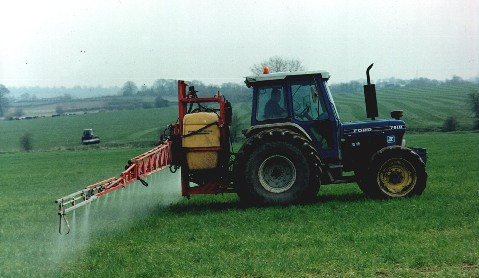SPECIAL UPDATE - FRIDAY APRIL 11Crop now at TI stage

Spraying got underway this week
Crop now at the T1 stage. To control foliar disease and Take-all David Jordan applied a mix of Amistar (active ingredient azoxystrobin) at the rate of 1 litre per hectare, Bravo (active ingredient chlorothalonil ) also at the rate of 1 litre per hectare, and Menara (active ingredients propicazole and cyproconazole ) at the rate of 0.3 litre per hectare earlier this week. Low levels of Septoria Tritici were apparent within the crop prior to spraying.
Also included in the tank mix was the growth regulator Moddus (active ingredient trinexapac - ethyl) at the rate of 0.2 litres per hectare and Chloromaquat at the rate of 1.25 litres per hectare.
The crop, a fourth consecutive wheat, was sown out on October 04 at a seed rate of 10 stone per acre and was topped dressed with Nitrogen (40 units per acre) on March 19.
"We are delighted with the progress made to date courtesy of the project," confirmed Syngenta's Raymond Hilman.
"Given the very professional approach of David, the crop is being managed in a very proactive manner. As a result local cereal growers will be able to use Crop Watch as an aid to predicting cereal disease levels and the options they have in best managing their own wheat crops through to harvest."
He added:
"In 2002 FRAC member companies put in place a Septoria resistance to
strobilurins monitoring programme. The results from that programme led to
the FRAC announcement at the beginning of this year that low levels of
Septoria resistance to strobilurin fungicides had been detected in Northern
Europe.
Since that time, Syngenta has implemented a follow-up, pre-season Septoria
resistance monitoring programme, the results of which are becoming
available. Early indications show that resistant Septoria has built up over
the winter at a faster rate and is more widespread in the UK than expected."
As a consequence of these results, the Syngenta position on the use of
strobilurin containing product is:
* As the degree of resistance in any one field cannot be predicted and
as the relationship between resistance occurrence and impact on field
performance is not currently understood, strobilurins should not be relied
upon as the sole method of controlling Septoria.
* Where resistance does occur it may reduce the control provided by
strobilurins and therefore yields, if suitable anti-resistant/resistance
containment strategies are not implemented.
An effective containment strategy should consist of:
* A maximum of two sprays of strobilurin containing products.
* Always use with a Septoria active partner at effective recommended
dose rates.
* Bravo and triazoles should form a key part of programmes at T0
(where applied) and T1 and T2.
* Integral to this is the appropriate use of the multi-site fungicide
Bravo (chlorothalonil) for which no resistance has been detected. By
incorporating Bravo into spray programmes, the aim is to cover the top four,
key wheat leaves - so that any resistant isolates are exposed to its
multi-site activity.
* Over-reliance on the curative activity of strobilurins will
accelerate the spread of resistance and lead to reduced control.
Syngenta has developed a range of regional crop guidelines which provide
anti-resistance programmes for milling and feed wheat. Copies of these
guidelines will be made available to you from your local Syngenta contact.
Broad-spectrum strobilurins, such as Amistar (azoxystrobin), control yellow
and brown rusts, Septoria nodorum and sharp eyespot, and there are also
strobilurin physiological benefits - such as delayed senescence - for which
there is new research data for Acanto (picoxystrobin) and Amistar.
Uniquely, Amistar offers take all control, and also has well-known yield and
quality benefits as an ear spray.
Click here to return to Crop Watch home page
|





